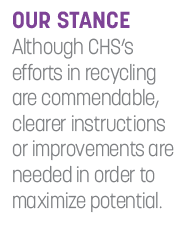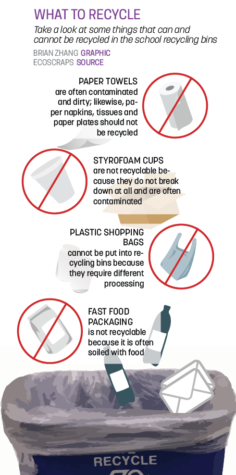In this day and age, with the planet’s temperature consistently increasing and sea levels rising, it’s vital to make little changes to culminate to a greater overall effect. However, it’s not hard to accidentally throw away recyclable items like papers, magazines and bottles into a trash can. A large school like CHS that consumes a large supply of resources has a substantial carbon footprint, but throughout the years, CHS’s Environmental Action Club and administration have worked in conjunction to lessen this effect.
With this in mind, this school year the administration implemented a policy of converting all classroom trash cans to recycle-only bins, while trash cans in the hallway would serve as a place to collect non-recyclable items. The policy aims to ease problems associated with forgetting to recycle.
However, while most classrooms have signs advising students not to throw away food and drink in these classroom bins, many students are not actually aware of this and they continue to utilize the trash can as they have in past years. Furthermore, few teachers have explained the policy to students, so those students may no t be aware of the change to begin with. Some of this may partially be due to the fact that teachers themselves do not completely understand the policy. In many classrooms, there are still separate recycling bins and “trash” cans, although they serve the same purpose. This gives the idea that the “trash” can is still used for all items, while the recycling bin is used solely for recycle-only items.
t be aware of the change to begin with. Some of this may partially be due to the fact that teachers themselves do not completely understand the policy. In many classrooms, there are still separate recycling bins and “trash” cans, although they serve the same purpose. This gives the idea that the “trash” can is still used for all items, while the recycling bin is used solely for recycle-only items.
We encourage the administration to clarify and refine the implementation of these policies. The effort to recycle more is essential to our future, so it is gratifying to know that the school cares and actively works toward fixing these issues. However, we propose certain changes that would make the policy more effective.
First, teachers and students both need to be informed of exactly where they can put recyclable items and non-recyclable items. This needs to be communicated through some means so that all students are aware of the policy. Additionally, traditional “trash cans” and recycling bins should be labeled in the same way, so there is no confusion about the difference between the two.
We also encourage the school to look into the recycling programs in airports and other cafeterias for our own cafeterias. In these places, there is a separate trash can for compostable waste/food, for recyclable items and for trash, with an explanation of what items belong where on each can. Most of us will always try to recycle if we can, so having the separated disposal sites in front of us while throwing away our food is an easy and effective way to get students to recycle more.
We hope the administration continues its strides to make CHS greener.If we can continue these improvements, our impact will be even more significant.




























![Keep the New Gloves: Fighter Safety Is Non-Negotiable [opinion]](https://hilite.org/wp-content/uploads/2024/12/ufcglovescolumncover-1200x471.png)
















































![Review: “We Live in Time” leaves you wanting more [MUSE]](https://hilite.org/wp-content/uploads/2024/12/IMG_6358.jpg)
![Review: The premise of "Culinary Class Wars" is refreshingly unique and deserving of more attention [MUSE]](https://hilite.org/wp-content/uploads/2024/12/MUSE-class-wars-cover-2.png)
![Introducing: "The Muses Who Stole Christmas," a collection of reviews for you to follow through winter [MUSE]](https://hilite.org/wp-content/uploads/2024/12/winter-muse-4.gif)
![Review: "Meet Me Next Christmas" is a cheesy and predictable watch, but it was worth every minute [MUSE]](https://hilite.org/wp-content/uploads/2024/11/AAAAQVfRG2gwEuLhXTGm3856HuX2MTNs31Ok7fGgIVCoZbyeugVs1F4DZs-DgP0XadTDrnXHlbQo4DerjRXand9H1JKPM06cENmLl2RsINud2DMqIHzpXFS2n4zOkL3dr5m5i0nIVb3Cu3ataT_W2zGeDAJNd_E-1200x884.jpg)
![Review: "Gilmore Girls", the perfect fall show [MUSE]](https://hilite.org/wp-content/uploads/2024/11/gilmore-girls.png)
![Review in Print: Maripaz Villar brings a delightfully unique style to the world of WEBTOON [MUSE]](https://hilite.org/wp-content/uploads/2023/12/maripazcover-1200x960.jpg)
![Review: “The Sword of Kaigen” is a masterpiece [MUSE]](https://hilite.org/wp-content/uploads/2023/11/Screenshot-2023-11-26-201051.png)
![Review: Gateron Oil Kings, great linear switches, okay price [MUSE]](https://hilite.org/wp-content/uploads/2023/11/Screenshot-2023-11-26-200553.png)
![Review: “A Haunting in Venice” is a significant improvement from other Agatha Christie adaptations [MUSE]](https://hilite.org/wp-content/uploads/2023/11/e7ee2938a6d422669771bce6d8088521.jpg)
![Review: A Thanksgiving story from elementary school, still just as interesting [MUSE]](https://hilite.org/wp-content/uploads/2023/11/Screenshot-2023-11-26-195514-987x1200.png)
![Review: "When I Fly Towards You", cute, uplifting youth drama [MUSE]](https://hilite.org/wp-content/uploads/2023/09/When-I-Fly-Towards-You-Chinese-drama.png)
![Postcards from Muse: Hawaii Travel Diary [MUSE]](https://hilite.org/wp-content/uploads/2023/09/My-project-1-1200x1200.jpg)
![Review: "Ladybug & Cat Noir: The Movie," departure from original show [MUSE]](https://hilite.org/wp-content/uploads/2023/09/Ladybug__Cat_Noir_-_The_Movie_poster.jpg)
![Review in Print: "Hidden Love" is the cute, uplifting drama everyone needs [MUSE]](https://hilite.org/wp-content/uploads/2023/09/hiddenlovecover-e1693597208225-1030x1200.png)
![Review in Print: "Heartstopper" is the heartwarming queer romance we all need [MUSE]](https://hilite.org/wp-content/uploads/2023/08/museheartstoppercover-1200x654.png)



